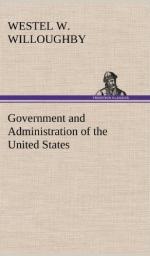The power to tax is legislative, and, according to our theory, can be exercised only by representatives directly elected by the people. The refusal of England in the last century to extend this principle of “no taxation without representation” to her colonies in America, lost her these possessions. A government to be stable and efficient must possess adequate powers for the collection of its revenue. The miserable condition to which the old Confederation was reduced by reason of the inadequacy of its powers in this respect, has already been discussed. Says Fiske: “Between the old Continental Congress and the government under which we have lived since 1789, the differences were many; but by far the most essential difference was that the new government could raise money by taxation, and was thus enabled properly to carry on the work of governing."[1]
[Footnote 1: Civil Government, p. 77.]
The sources of government revenue other than taxes, are various, and differ in different countries. In our consideration of the revenues and expenditures of our national, state, and local governments we shall have occasion to notice the various means by which their treasuries are filled.
_#The Federal Government#_ raises its revenues independently of the other governing bodies, from different sources, and by a different set of officials. Besides taxation, the principal source of revenue is from the sale of public lands. Federal taxes are of two kinds:
1. Customs duties.
2. Excise or internal revenue duties.
Of these, much the greater sum is raised from customs duties. For the year 1889,[1] the total net receipts were $387,050,058. Of this $223,832,741 was derived from customs, and $130,894,434 from the internal revenue duties. The sale of public lands yielded in that year $8,038,651. The miscellaneous revenues amounted to $24,297,151.
[Footnote 1: For fiscal purposes the year begins July 1st.]
Customs or tariff duties are taxes which have to be paid on a large class of goods imported into this country from foreign countries. These charges are collected by Government collectors, stationed in all our principal seaport cities, who inspect all incoming vessels and determine the amount to be paid, according to the rate determined by Congress. This system constitutes the so-called protective tariff policy of our country. Those commodities not so taxed are said to be on the “free list.” How much, and on what articles these duties shall be levied, is the question upon which the Republican and Democratic parties differ; the former favoring high, and the latter low rates, that is to say merely enough to support the Government, or, as it is termed, “a tariff for revenue only.”




